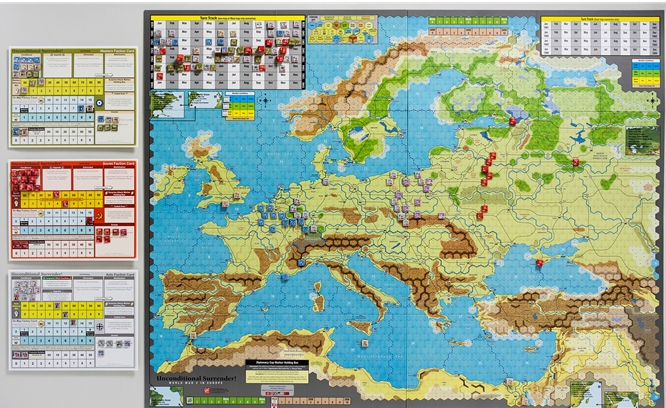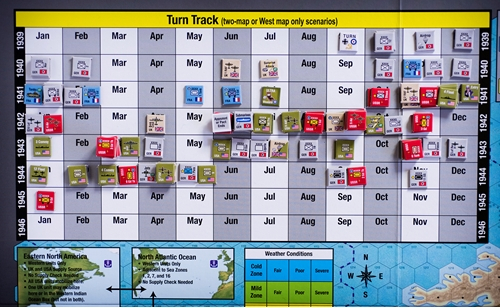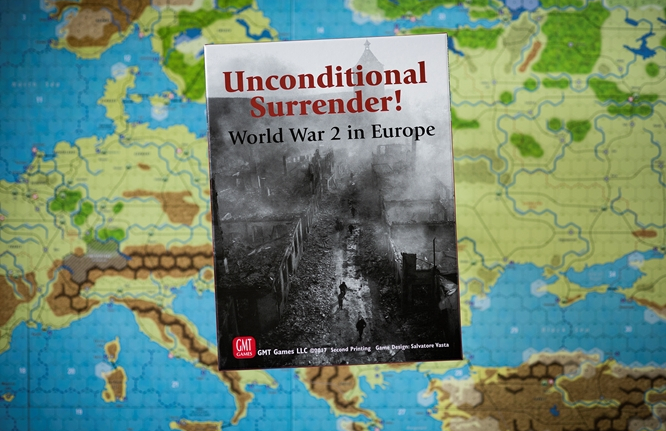This piece is from Clio, who runs the Clio’s Board Games blog and Twitter account dedicated to musings on history, board games, and history in board games. He holds an M.A. in history (obtained with a thesis on the Cold War in board games) and has since then worked in the decidedly non-scholarly fields of election campaigning, the management of politics, and real estate. Clio has been a board gamer since elementary school with an ever-growing amount of gaming dedicated to historical conflicts from antiquity to the 21st century.
In the below post, Clio discusses a new approach to writing after-action reports.
I love after-action reports (AARs). They allow me to share the author’s excitement, and to vicariously experience games I cannot play. And, if written well, they can be small pieces of (fictional) historiography, and even literature.
Recently, I have taken to writing my own AARs. I wanted to solo a full campaign of Unconditional Surrender! (Salvatore Vasta, GMT Games), and thought I’d get more out of it if other people could share in it. (Spoiler: I did.) My goal was to overcome some of the issues I saw in many other AARs and try out a different approach in perspective, content, and interactivity. Here’s how it turned out.
An All-Too Common Perspective
Every AAR has one (or several) perspectives.
- Typically, there is a certain amount of auctorial perspective to orient the readers (the player sharing their general knowledge of scenario and rules, which usually far exceeds that which any given individual in the scenario would have had in history).
- If there are two or more players, the author can take their own personal perspective.
- Finally, there is the perspective of a historical character, typically the one that aligns closest with what you are representing in the game.
The second and third perspectives are similar, but differ in how they tell things–treating the game as a game (personal perspective) or as (fictional) history. Writing from a personal perspective, you might say “I positioned few, but strong blocks at Hougoumont and trusted that their +2 defensive modifier would be enough to repel the French.” The historical perspective (of the Duke of Wellington) would be “While I could not spare too many soldiers to defend Hougoumont, I trusted that the Coldstream Guards and King’s German Legion would repel any French advances with their disciplined, rapid fire.” Note that this is not about pronouns – both perspectives could also be written in the third person (“The Anglo-Allied player positioned…” and “While the Duke of Wellington could not…”).

The perspective of the historical character is a little bit more difficult to write (after all, you’re writing someone who isn’t you-the-player), but has a particular lure for many writers (and readers) – your game is an alternative history generator, and your AAR the matching historiography.
As said above, the typical historical perspective is that of the person or entity which you represent with your player actions. So, there are a lot of AARs written from the perspective of kings and generals. And as long as most games that take their subject matter seriously focus on warfare and statecraft, the AARs will as well.
In my opinion, that’s a pity! There are so many more historical perspectives to explore – and just because an AAR is about a particular game, it doesn’t need to remain within the confines of that game. It’s your medium as a writer, so use the freedom you have!
World War II Fought Anew…on Twitter and the Blog
Thus, I set out to write my Unconditional Surrender! AAR differently. Before I started, I summarized my intentions:
I’ll create an alternative history in documents and fragments – letters, newspaper articles, orders, diary entries, etc.
My goal is to avoid telling the easy story. Therefore, I’ll apply the following guidelines to the narrative:
- History – not only made from above. Sure, generals and presidents make for interesting historical actors, but so do ordinary people.
- History – not only made by soldiers. The sailor in the merchant navy crossing a U-boat-ridden Atlantic, the peasant whose horses were commandeered, the retiree in the occupied city: They all have stories to tell.
- History – not only made by those who drive the action. As World War II goes, the Allies will be mostly reacting to the attacking Axis armies on their rampage through Europe until 1941/1942. Still, I want to give the Polish, French, or Soviets a voice.
- History – not only made by the great powers. Most of what you read about World War II is devoted to the countries with the most powerful armies and most productive economies. I want to add the perspective of the people from the smaller nations as well.
These documents could be read on my blog, and I would include them in the (very long) thread on Twitter where the more traditional part, the advancing and retreating of the armies, would also be told.

As Unconditional Surrender! is a lengthy game (listed at 50-100 hours for a full campaign, and the AAR ran for over a year in total), I wanted to maintain engagement by making my readers an integral part of the experience. So, I let them decide on the strategies pursued. Whenever a big decision was to be made, I turned it into a Twitter poll. From the Axis’s first strike to its eponymous unconditional surrender (and beyond… more on that later), the Twitter community got to call the shots.
How Did It Turn Out?
As the author of the AAR: I thought it was a worthwhile experience. And from the responses I got from the Twitter community and on the blog, a lot of other people did, too.
On Twitter, I built a committed little community of AAR followers who’d vote on every poll and give their strategic opinions. That was so engaging (and the responses I got so positive) that I decided a few weeks after the AAR had wrapped up that I’d do a sequel and stretch the boundaries even further – I’d do a Soviet attack on the Western positions from the situation in which the original AAR ended. Most of the people who had followed the original AAR kept up with this one as well, and as I’ve since done a Here I Stand (Ed Beach, GMT Games) Twitter community game and another Unconditional Surrender! AAR (with growing participant and spectator numbers), I count it as a success for the community.
Sometimes there were even moral questions to make: The Soviet-Western war included the use of nuclear weapons. If and where to drop them is something that the community treated with great care (and also discussed intensively).
As no decision can be reached, the White House decides not to use the bomb this month and strike in May with doubled strength. #USEAAR
— Clio's Board Games (@cliosboardgames) November 25, 2020
This perspective also arose without subjects as delicate as this. When the question arose in the second Unconditional Surrender! AAR if the Western Allies should invade the (neutral, but Axis-leaning) Netherlands and thus outflank the German frontline in the west, long-time AAR follower Paul Hodson argued forcefully for a Western policy that was in keeping with its moral values. Paul carried the day.
Possibly biased by the fact that NL is where I currently live. But I would prefer the Allies to win in a creditable way.
— Paul H HODSON (@PaulHHodson) January 9, 2022
My assessment of the use of documents (which were supposed to broaden the perspectives taken in the AAR) is more mixed. It gave me an opportunity to write pieces ranging from the diary of a teacher in much-fought-over Brussels to a propaganda leaflet of the Italian forces occupying parts of Germany. For some subjects like the genocide on the Eastern Front, I decided that writing fictional documents was inappropriate, and thus I translated original documents. Personally, I am content with the mosaic I put together, but I am not sure how many people following the AAR on Twitter took the time to read these documents (and the blog posts themselves attracted a lot fewer views than my usual posts).
Finally, for anyone who wants to emulate this approach: It’s a lot of work. Writing the tweets and accompanying them with screenshots of the Vassal module was easy, but the graphics that I made to illustrate the strategic options in the polls, the animated GIFs to show the developments at the front, and not least of all writing the documents took way more time than I expected in the beginning. So, for my second Unconditional Surrender! AAR I decided to make do without the documents.
Overall, I count my breaking of new ground in the Art of AAR as a success. It was enjoyable for me and for the community – and maybe it will inspire others, too!
You can follow Clio on Twitter here, and check out their site here.
[Game component photos from Scott Mansfield for GMT Games; check out his Twitter account and website for more]
